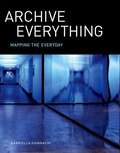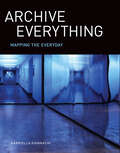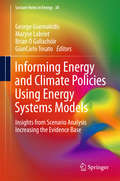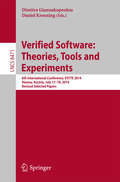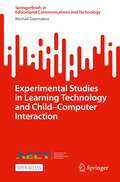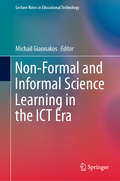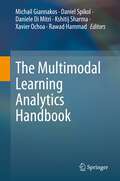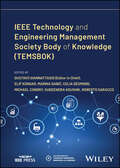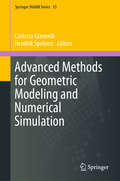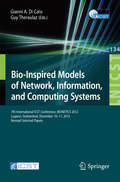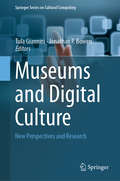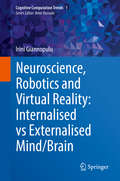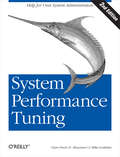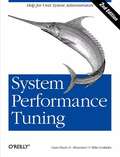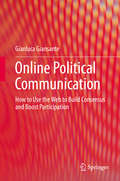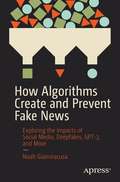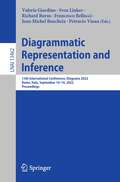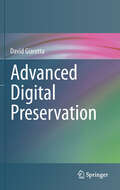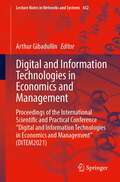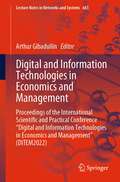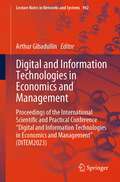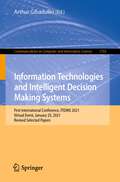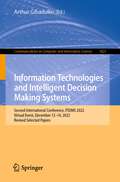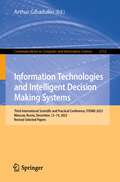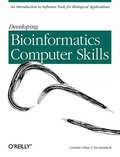- Table View
- List View
Archive Everything: Mapping the Everyday
by Gabriella GiannachiIn Archive Everything, Gabriella Giannachi traces the evolution of the archive into the apparatus through which we map the everyday. The archive, traditionally a body of documents or a site for the preservation of documents, changed over the centuries to encompass, often concurrently, a broad but interrelated number of practices not traditionally considered as archival. Archives now consist of not only documents and sites but also artworks, installations, museums, social media platforms, and mediated and mixed reality environments. Giannachi tracks the evolution of these diverse archival practices across the centuries. Archives today offer a multiplicity of viewing platforms to replay the past, capture the present, and map our presence. Giannachi uses archaeological practices to explore all the layers of the archive, analyzing Lynn Hershman Leeson's !Women Art Revolution project, a digital archive of feminist artists. She considers the archive as a memory laboratory, with case studies that include visitors' encounters with archival materials in the Jewish Museum in Berlin. She discusses the importance of participatory archiving, examining the "multimedia roadshow" Digital Diaspora Family Reunion as an example. She explores the use of the archive in works that express the relationship between ourselves and our environment, citing Andy Warhol and Ant Farm, among others. And she looks at the transmission of the archive through the body in performance, bioart, and database artworks, closing with a detailed analysis of Lynn Hershman Leeson's Infinity Engine.
Archive Everything: Mapping the Everyday
by Gabriella GiannachiHow the archive evolved to include new technologies, practices, and media, and how it became the apparatus through which we map the everyday.In Archive Everything, Gabriella Giannachi traces the evolution of the archive into the apparatus through which we map the everyday. The archive, traditionally a body of documents or a site for the preservation of documents, changed over the centuries to encompass, often concurrently, a broad but interrelated number of practices not traditionally considered as archival. Archives now consist of not only documents and sites but also artworks, installations, museums, social media platforms, and mediated and mixed reality environments. Giannachi tracks the evolution of these diverse archival practices across the centuries. Archives today offer a multiplicity of viewing platforms to replay the past, capture the present, and map our presence. Giannachi uses archaeological practices to explore all the layers of the archive, analyzing Lynn Hershman Leeson's !Women Art Revolution project, a digital archive of feminist artists. She considers the archive as a memory laboratory, with case studies that include visitors' encounters with archival materials in the Jewish Museum in Berlin. She discusses the importance of participatory archiving, examining the “multimedia roadshow” Digital Diaspora Family Reunion as an example. She explores the use of the archive in works that express the relationship between ourselves and our environment, citing Andy Warhol and Ant Farm, among others. And she looks at the transmission of the archive through the body in performance, bioart, and database artworks, closing with a detailed analysis of Lynn Hershman Leeson's Infinity Engine.
Informing Energy and Climate Policies Using Energy Systems Models
by George Giannakidis Maryse Labriet Brian Ó Gallachóir Giancarlo TosatoThis book highlights how energy-system models are used to underpin and support energy and climate mitigation policy decisions at national, multi-country and global levels. It brings together, for the first time in one volume, a range of methodological approaches and case studies of good modeling practice on a national and international scale from the IEA-ETSAP energy technology initiative. It provides insights for the reader into the rich and varied applications of energy-system models and the underlying methodologies and policy questions they can address. The book demonstrates how these models are used to answer complex policy questions, including those relating to energy security, climate change mitigation and the optimal allocation of energy resources. It will appeal to energy engineers and technology specialists looking for a rationale for innovation in the field of energy technologies and insights into their evolving costs and benefits. Energy economists will gain an understanding of the key future role of energy technologies and policy makers will learn how energy-system modeling teams can provide unique perspectives on national energy and environment challenges. The book is carefully structured into three parts which focus on i) policy decisions that have been underpinned by energy-system models, ii) specific aspects of supply and end-use sector modeling, including technology learning and behavior and iii) how additional insights can be gained from linking energy-system models with other models. The chapters elucidate key methodological features backed up with concrete applications. The book demonstrates the high degree of flexibility of the modeling tools used to represent extremely different energy systems, from national to global levels.
Verified Software: Theories, Tools and Experiments
by Dimitra Giannakopoulou Daniel KroeningThis volume constitutes the thoroughly refereed post-conference proceedings of the 6th International Conference on Verified Software: Theories, Tools and Experiments, VSTTE 2014, held in July 2014 at the Vienna Summer of Logic in Vienna, Austria, as an associated event of CAV 2014, the International Conference on Computer-Aided Verification. The 17 revised full papers presented were carefully revised and selected from 34 submissions. The papers are organized in topical sections such as analysis: understanding and explanation; verification frameworks and applications; hypervisors and dynamic data structures; certification; real time and security.
Experimental Studies in Learning Technology and Child–Computer Interaction (SpringerBriefs in Educational Communications and Technology)
by Michail GiannakosThis book is about the ways in which experiments can be employed in the context of research on learning technologies and child–computer interaction (CCI). It is directed at researchers, supporting them to employ experimental studies while increasing their quality and rigor. The book provides a complete and comprehensive description on how to design, implement, and report experiments, with a focus on and examples from CCI and learning technology research. The topics covered include an introduction to CCI and learning technologies as interdisciplinary fields of research, how to design educational interfaces and visualizations that support experimental studies, the advantages and disadvantages of a variety of experiments, methodological decisions in designing and conducting experiments (e.g. devising hypotheses and selecting measures), and the reporting of results. As well, a brief introduction on how contemporary advances in data science, artificial intelligence, and sensor data have impacted learning technology and CCI research is presented. The book details three important issues that a learning technology and CCI researcher needs to be aware of: the importance of the context, ethical considerations, and working with children. The motivation behind and emphasis of this book is helping prospective CCI and learning technology researchers (a) to evaluate the circumstances that favor (or do not favor) the use of experiments, (b) to make the necessary methodological decisions about the type and features of the experiment, (c) to design the necessary “artifacts” (e.g., prototype systems, interfaces, materials, and procedures), (d) to operationalize and conduct experimental procedures to minimize potential bias, and (e) to report the results of their studies for successful dissemination in top-tier venues (such as journals and conferences).This book is an open access publication.
Non-Formal and Informal Science Learning in the ICT Era (Lecture Notes in Educational Technology)
by Michail GiannakosThis book introduces the reader to evidence-based non-formal and informal science learning considerations (including technological and pedagogical innovations) that have emerged in and empowered the information and communications technology (ICT) era. The contributions come from diverse countries and contexts (such as hackerspaces, museums, makerspaces, after-school activities) to support a wide range of educators, practitioners, and researchers (such as K-12 teachers, learning scientists, museum curators, librarians, parents, hobbyists). The documented considerations, lessons learned, and concepts have been extracted using diverse methods, ranging from experience reports and conceptual methods to quantitative studies and field observation using qualitative methods. This volume attempts to support the preparation, set-up, implementation, but also evaluation of informal learning activities to enhance science education.
The Multimodal Learning Analytics Handbook
by Michail Giannakos Daniel Spikol Daniele Di Mitri Kshitij Sharma Xavier Ochoa Rawad HammadThis handbook is the first book ever covering the area of Multimodal Learning Analytics (MMLA). The field of MMLA is an emerging domain of Learning Analytics and plays an important role in expanding the Learning Analytics goal of understanding and improving learning in all the different environments where it occurs. The challenge for research and practice in this field is how to develop theories about the analysis of human behaviors during diverse learning processes and to create useful tools that could augment the capabilities of learners and instructors in a way that is ethical and sustainable. Behind this area, the CrossMMLA research community exchanges ideas on how we can analyze evidence from multimodal and multisystem data and how we can extract meaning from this increasingly fluid and complex data coming from different kinds of transformative learning situations and how to best feed back the results of these analyses to achieve positive transformative actions on those learning processes. This handbook also describes how MMLA uses the advances in machine learning and affordable sensor technologies to act as a virtual observer/analyst of learning activities. The book describes how this “virtual nature” allows MMLA to provide new insights into learning processes that happen across multiple contexts between stakeholders, devices and resources. Using such technologies in combination with machine learning, Learning Analytics researchers can now perform text, speech, handwriting, sketches, gesture, affective, or eye-gaze analysis, improve the accuracy of their predictions and learned models and provide automated feedback to enable learner self-reflection. However, with this increased complexity in data, new challenges also arise. Conducting the data gathering, pre-processing, analysis, annotation and sense-making, in a way that is meaningful for learning scientists and other stakeholders (e.g., students or teachers), still pose challenges in this emergent field. This handbook aims to serve as a unique resource for state of the art methods and processes. Chapter 11 of this book is available open access under a CC BY 4.0 license at link.springer.com.
IEEE Technology and Engineering Management Society Body of Knowledge (IEEE Press Series on Technology Management, Innovation, and Leadership)
by Gustavo Giannattasio Elif Kongar Marina Dabić Celia Desmond Michael Condry Sudeendra Koushik Roberto SaraccoIEEE Technology and Engineering Management Society Body of Knowledge (TEMSBOK) IEEE TEMS Board of Directors-approved body of knowledge dedicated to technology and engineering management The IEEE Technology and Engineering Management Society Body of Knowledge (TEMSBOK) establishes a set of common practices for technology and engineering management, acts as a reference for entrepreneurs, establishes a basis for future official certifications, and summarizes the literature on the management field in order to publish reference documentation for new initiatives. The editors have used a template approach with authors that instructed them on how to introduce their manuscript, how to organize the technology and area fundamentals, the managing approach, techniques and benefits, realistic examples that show the application of concepts, recommended best use (focusing on how to identify the most adequate approach to typical cases), with a summary and conclusion of each section, plus a list of references for further study. The book is structured according to the following area knowledge chapters: business analysis, technology adoption, innovation, entrepreneurship, project management, digital disruption, digital transformation of industry, data science and management, and ethics and legal issues. Specific topics covered include: Market requirement analysis, business analysis for governance planning, financial analysis, evaluation and control, and risk analysis of market opportunities Leading and managing working groups, optimizing group creation and evolution, enterprise agile governance, and leading agile organizations and working groups Marketing plans for new products and services, risk analysis and challenges for entrepreneurs, and procurement and collaboration Projects, portfolios and programs, economic constraints and roles, integration management and control of change, and project plan structure The IEEE Technology and Engineering Management Society Body of Knowledge (TEMSBOK) will appeal to engineers, graduates, and professionals who wish to prepare for challenges in initiatives using new technologies, as well as managers who are responsible for conducting business involving technology and engineering.
Advanced Methods for Geometric Modeling and Numerical Simulation (Springer INdAM Series #35)
by Carlotta Giannelli Hendrik SpeleersThis book gathers selected contributions presented at the INdAM Workshop “DREAMS”, held in Rome, Italy on January 22−26, 2018. Addressing cutting-edge research topics and advances in computer aided geometric design and isogeometric analysis, it covers distinguishing curve/surface constructions and spline models, with a special focus on emerging adaptive spline constructions, fundamental spline theory and related algorithms, as well as various aspects of isogeometric methods, e.g. efficient quadrature rules and spectral analysis for isogeometric B-spline discretizations. Applications in finite element and boundary element methods are also discussed. Given its scope, the book will be of interest to both researchers and graduate students working in these areas.
Bio-Inspired Models of Network, Information, and Computing Systems: 7th International ICST Conference, BIONETICS 2012, Lugano, Switzerland, December 10--11, 2012, Revised Selected Papers (Lecture Notes of the Institute for Computer Sciences, Social Informatics and Telecommunications Engineering #134)
by Gianni A. Di Caro Guy TheraulazThis book constitutes the thoroughly refereed post-conference proceedings of the 7th International Conference on Bio-Inspired Models of Network, Information and Computing Systems (Bionetics 2012), held in Lugano, Switzerland, in December 2012. The 23 revised full papers presented were carefully reviewed and selected from 40 submissions. They cover topics such as networking, robotics and neural networks, molecular scale and bioinformatics, optimization and bio-inspired modeling in various fields.
Museums and Digital Culture: New Perspectives and Research (Springer Series on Cultural Computing)
by Tula Giannini Jonathan P. BowenThis book explores how digital culture is transforming museums in the 21st century. Offering a corpus of new evidence for readers to explore, the authors trace the digital evolution of the museum and that of their audiences, now fully immersed in digital life, from the Internet to home and work. In a world where life in code and digits has redefined human information behavior and dominates daily activity and communication, ubiquitous use of digital tools and technology is radically changing the social contexts and purposes of museum exhibitions and collections, the work of museum professionals and the expectations of visitors, real and virtual. Moving beyond their walls, with local and global communities, museums are evolving into highly dynamic, socially aware and relevant institutions as their connections to the global digital ecosystem are strengthened. As they adopt a visitor-centered model and design visitor experiences, their priorities shift to engage audiences, convey digital collections, and tell stories through exhibitions. This is all part of crafting a dynamic and innovative museum identity of the future, made whole by seamless integration with digital culture, digital thinking, aesthetics, seeing and hearing, where visitors are welcomed participants. The international and interdisciplinary chapter contributors include digital artists, academics, and museum professionals. In themed parts the chapters present varied evidence-based research and case studies on museum theory, philosophy, collections, exhibitions, libraries, digital art and digital future, to bring new insights and perspectives, designed to inspire readers. Enjoy the journey!
Neuroscience, Robotics and Virtual Reality: Internalized Vs Externalized Mind/brain (Cognitive Computation Trends #1)
by Irini GiannopuluThis is the first volume in the Cognitive Computation Trends book series, summarising our understanding on the neural correlate of memory, perception-representation, action, language, emotion and consciousness and their mutual interactions. Integrating research in the field of the Neuroscience, Robotics and Virtual Reality, this book is an original and attainable resource that has not been developed in any other writing. In 5 chapters, the author considers that representations are based on allegorical traces and are consciously and/or unconsciously embrained, and that the creation of robots is the expression of the mind. Whole-body virtual motion is thought of as the archetypal expression of virtual reality. Therefore, visual reality is analysed in a context of visuo-vestibular and somesthetic conflict while mixed and augmented reality are scrutinised in a context of visuo-vestibular and somesthetic interaction. This monograph is an indispensable handbook for students and investigators engaged in history of science, philosophy, psychology, neuroscience, engineering and those interested in there interconnections. The ambition of the book is to give students and investigators ideas on which they can build their future research in this new blooming area.
System Performance Tuning
by Gian-Paolo D. Musumeci Mike LoukidesSystem Performance Tuning answers one of the most fundamental questions you can ask about your computer: How can I get it to do more work without buying more hardware? In the current economic downturn, performance tuning takes on a new importance. It allows system administrators to make the best use of existing systems and minimize the purchase of new equipment. Well-tuned systems save money and time that would otherwise be wasted dealing with slowdowns and errors. Performance tuning always involves compromises; unless system administrators know what the compromises are, they can't make intelligent decisions. Tuning is an essential skill for system administrators who face the problem of adapting the speed of a computer system to the speed requirements imposed by the real world. It requires a detailed understanding of the inner workings of the computer and its architecture. System Performance Tuning covers two distinct areas: performance tuning, or the art of increasing performance for a specific application, and capacity planning, or deciding what hardware best fulfills a given role. Underpinning both subjects is the science of computer architecture. This book focuses on the operating system, the underlying hardware, and their interactions. Topics covered include: Real and perceived performance problems, introducing capacity planning and performance monitoring (highlighting their strengths and weaknesses). An integrated description of all the major tools at a system administrator's disposal for tracking down system performance problems. Background on modern memory handling techniques, including the memory-caching filesystem implementations in Solaris and AIX. Updated sections on memory conservation and computing memory requirements. In depth discussion of disk interfaces, bandwidth capacity considerations, and RAID systems. Comprehensive discussion of NFS and greatly expanded discussion of networking. Workload management and code tuning. Special topics such as tuning Web servers for various types of content delivery and developments in cross-machine parallel computing For system administrators who want a hands-on introduction to system performance, this is the book to recommend.
System Performance Tuning, 2nd Edition
by Gian-Paolo D. Musumeci Mike LoukidesSystem Performance Tuning answers one of the most fundamental questions you can ask about your computer: How can I get it to do more work without buying more hardware? In the current economic downturn, performance tuning takes on a new importance. It allows system administrators to make the best use of existing systems and minimize the purchase of new equipment. Well-tuned systems save money and time that would otherwise be wasted dealing with slowdowns and errors. Performance tuning always involves compromises; unless system administrators know what the compromises are, they can't make intelligent decisions. Tuning is an essential skill for system administrators who face the problem of adapting the speed of a computer system to the speed requirements imposed by the real world. It requires a detailed understanding of the inner workings of the computer and its architecture. System Performance Tuning covers two distinct areas: performance tuning, or the art of increasing performance for a specific application, and capacity planning, or deciding what hardware best fulfills a given role. Underpinning both subjects is the science of computer architecture. This book focuses on the operating system, the underlying hardware, and their interactions. Topics covered include: Real and perceived performance problems, introducing capacity planning and performance monitoring (highlighting their strengths and weaknesses). An integrated description of all the major tools at a system administrator's disposal for tracking down system performance problems. Background on modern memory handling techniques, including the memory-caching filesystem implementations in Solaris and AIX. Updated sections on memory conservation and computing memory requirements. In depth discussion of disk interfaces, bandwidth capacity considerations, and RAID systems. Comprehensive discussion of NFS and greatly expanded discussion of networking. Workload management and code tuning. Special topics such as tuning Web servers for various types of content delivery and developments in cross-machine parallel computing For system administrators who want a hands-on introduction to system performance, this is the book to recommend.
Online Political Communication
by Gianluca GiansanteThis book provides research findings and practical information on online communication strategies in politics. Based on communication research and real-world political-campaign experience, the author examines how to use the Web and social media to create public visibility, build trust and consensus and boost political participation. It offers a useful guide for practitioners working in the political arena, as well as for those managing communication projects in institutions or companies.
How Algorithms Create and Prevent Fake News: Exploring the Impacts of Social Media, Deepfakes, GPT-3, and More
by Noah GiansiracusaFrom deepfakes to GPT-3, deep learning is now powering a new assault on our ability to tell what’s real and what’s not, bringing a whole new algorithmic side to fake news. On the other hand, remarkable methods are being developed to help automate fact-checking and the detection of fake news and doctored media. Success in the modern business world requires you to understand these algorithmic currents, and to recognize the strengths, limits, and impacts of deep learning---especially when it comes to discerning the truth and differentiating fact from fiction. This book tells the stories of this algorithmic battle for the truth and how it impacts individuals and society at large. In doing so, it weaves together the human stories and what’s at stake here, a simplified technical background on how these algorithms work, and an accessible survey of the research literature exploring these various topics. How Algorithms Create and Prevent Fake News is an accessible, broad account of the various ways that data-driven algorithms have been distorting reality and rendering the truth harder to grasp. From news aggregators to Google searches to YouTube recommendations to Facebook news feeds, the way we obtain information today is filtered through the lens of tech giant algorithms. The way data is collected, labelled, and stored has a big impact on the machine learning algorithms that are trained on it, and this is a main source of algorithmic bias – which gets amplified in harmful data feedback loops. Don’t be afraid: with this book you’ll see the remedies and technical solutions that are being applied to oppose these harmful trends. There is hope.What You Will LearnThe ways that data labeling and storage impact machine learning and how feedback loops can occurThe history and inner-workings of YouTube’s recommendation algorithmThe state-of-the-art capabilities of AI-powered text generation (GPT-3) and video synthesis/doctoring (deepfakes) and how these technologies have been used so farThe algorithmic tools available to help with automated fact-checking and truth-detectionWho This Book is ForPeople who don’t have a technical background (in data, computers, etc.) but who would like to learn how algorithms impact society; business leaders who want to know the powers and perils of relying on artificial intelligence. A secondary audience is people with a technical background who want to explore the larger social and societal impact of their work.
Diagrammatic Representation and Inference: 13th International Conference, Diagrams 2022, Rome, Italy, September 14–16, 2022, Proceedings (Lecture Notes in Computer Science #13462)
by Valeria Giardino Sven Linker Richard Burns Francesco Bellucci Jean-Michel Boucheix Petrucio VianaThis book constitutes the refereed proceedings of the 13th International Conference on the Theory and Application of Diagrams, Diagrams 2022, held in Rome, Italy, in September 2022. The 11 full papers and 19 short papers presented together with 5 posters were carefully reviewed and selected from 58 submissions. 8 chapters are available open access under a Creative Commons Attribution 4.0 International License via link.springer.com.
Advanced Digital Preservation
by David GiarettaThere is growing recognition of the need to address the fragility of digital information, on which our society heavily depends for smooth operation in all aspects of daily life. This has been discussed in many books and articles on digital preservation, so why is there a need for yet one more? Because, for the most part, those other publications focus on documents, images and webpages - objects that are normally rendered to be simply displayed by software to a human viewer. Yet there are clearly many more types of digital objects that may need to be preserved, such as databases, scientific data and software itself. David Giaretta, Director of the Alliance for Permanent Access, and his contributors explain why the tools and techniques used for preserving rendered objects are inadequate for all these other types of digital objects, and they provide the concepts, techniques and tools that are needed. The book is structured in three parts. The first part is on theory, i.e., the concepts and techniques that are essential for preserving digitally encoded information. The second part then shows practice, i.e., the use and validation of these tools and techniques. Finally, the third part concludes by addressing how to judge whether money is being well spent, in terms of effectiveness and cost sharing. Various examples of digital objects from many sources are used to explain the tools and techniques presented. The presentation style mainly aims at practitioners in libraries, archives and industry who are either directly responsible for preservation or who need to prepare for audits of their archives. Researchers in digital preservation and developers of preservation tools and techniques will also find valuable practical information here. Researchers creating digitally encoded information of all kinds will also need to be aware of these topics so that they can help to ensure that their data is usable and can be valued by others now and in the future. To further assist the reader, the book is supported by many hours of videos and presentations from the CASPAR project and by a set of open source software.
Digital and Information Technologies in Economics and Management: Proceedings of the International Scientific and Practical Conference "Digital and Information Technologies in Economics and Management" (DITEM2021) (Lecture Notes in Networks and Systems #432)
by Arthur GibadullinThis book addresses the issues of information, digital and intellectual technologies in economics and management. The International Scientific and Practical Conference "Digital and Information Technologies in Economics and Management" (DITEM2021) was held on November 2, 2021, on the Microsoft Teams platform due to COVID-19. A distinctive feature of the book is that it presented reports of authors from Italy, South Korea, Poland, Armenia, Republic of Belarus and the Russian Federation. Researchers from different countries presented the process of transition of economic activities to the information and digital path of development and presented the main directions and developments that can improve the efficiency and development of the economy and management. The book may be useful to state and regional authorities, international and supranational organizations, the scientific and professional community.
Digital and Information Technologies in Economics and Management: Proceedings of the International Scientific and Practical Conference "Digital and Information Technologies in Economics and Management" (DITEM2022) (Lecture Notes in Networks and Systems #683)
by Arthur GibadullinThis book covers the II International Scientific and Practical Conference "Digital and Information Technologies in Economics and Management" (DITEM2022), which was held on November 21–23, 2022. The conference addressed issues of information, digital and intellectual technologies in economics and management. A distinctive feature of the conference is that it presented reports of authors from China, Saudi Arabia, Tunisia, Uzbekistan, Tajikistan, Angola, Kazakhstan, India and Russia. Researchers from different countries presented the process of transition of economic activities to the information and digital path of development and presented the main directions and developments that can improve the efficiency and development of the economy and management. The materials of the conference may be useful to state and regional authorities, international and supranational organizations, the scientific and professional community.
Digital and Information Technologies in Economics and Management: Proceedings of the International Scientific and Practical Conference "Digital and Information Technologies in Economics and Management" (DITEM2023) (Lecture Notes in Networks and Systems #942)
by Arthur GibadullinThis book covers the III International Scientific and Practical Conference "Digital and Information Technologies in Economics and Management" (DITEM2023) which was held on November 21–23, 2023. The conference addressed issues of networks and systems related to the use of information technologies in economics and management of various sectors. A distinctive feature of the conference is that it featured presentations by authors from China, Bulgaria, Uzbekistan, Oman, Kazakhstan and Russia. Researchers from different countries presented the process of transition to new information technologies of various network and system structures and sectors. The conference made it possible to develop new scientific recommendations on the use of information, computer, digital and intellectual technologies and networks in industry and fields of activity that can be useful to state and regional authorities, international and supranational organizations, the scientific and professional community.
Information Technologies and Intelligent Decision Making Systems: First International Conference, ITIDMS 2021, Virtual Event, January 25, 2021, Revised Selected Papers (Communications in Computer and Information Science #1703)
by Arthur GibadullinThis book constitutes selected papers presented at the First International Scientific and Practical Conference on Information Technologies and Intelligent Decision Making Systems, ITIDMS 2021, held as Virtual Event in January, 2021.The 13 presented papers were thoroughly reviewed and selected from the 41 submissions. The conference was held with the aim of summarizing international experience in the field of information, digital and intellectual development, within which proposals were formulated for digital and information transformation, the development of computer models, information technologies, automated and computing processes. A distinctive feature of the conference is that it presented reports of authors from China, Uzbekistan, Lebanon, Poland, Kazakhstan, Bulgaria and Russia. Researchers from different countries presented the process of transition of the information and digital path of development, presented the main directions and developments that can improve the efficiency and development.
Information Technologies and Intelligent Decision Making Systems: Second International Conference, ITIDMS 2022, Virtual Event, December 12–14, 2022, Revised Selected Papers (Communications in Computer and Information Science #1821)
by Arthur GibadullinThis book constitutes the proceedings of the Second International Conference on Information Technologies and Intelligent Decision Making Systems, ITIDMS 2022, held as a virtual event, December 12–14, 2022.The 14 papers presented in this volume were carefully reviewed and selected from 38 submissions. The conference was held with the aim of developing and exchanging international experience in the field of information, digital and intellectual technologies, within the framework of which proposals were formulated for digital, intellectual and infor-mation transformation, the development of computer models and the improvement of automated and computing processes. A distinctive feature of the conference is that it presented reports of authors from USA, Canada, Bangladesh, Uzbekistan and Russia. Researchers from different countries presented the process of transition of the information and digital path of development, presented the main directions and de-velopments that can improve the efficiency and development.
Information Technologies and Intelligent Decision Making Systems: Third International Scientific and Practical Conference, ITIDMS 2023, Moscow, Russia, December, 12-14, 2023, Revised Selected Papers (Communications in Computer and Information Science #2112)
by Arthur GibadullinThis book constitutes the refereed post proceedings of the Third International Scientific and Practical Conference on Information Technologies and Intelligent Decision Making Systems, ITIDMS 2023, held in Moscow, Russia, during December, 12-14, 2023. The 18 full papers included in this book were carefully reviewed and selected from 54 submissions. The papers presented in this volume focus on topics such as digital, intellectual and information transformation, the development of computer models and the improvement of automated and computing processes.
Developing Bioinformatics Computer Skills
by Cynthia Gibas Per JambeckBioinformatics--the application of computational and analytical methods to biological problems--is a rapidly evolving scientific discipline. Genome sequencing projects are producing vast amounts of biological data for many different organisms, and, increasingly, storing these data in public databases. Such biological databases are growing exponentially, along with the biological literature. It's impossible for even the most zealous researcher to stay on top of necessary information in the field without the aid of computer-based tools. Bioinformatics is all about building these tools. Developing Bioinformatics Computer Skills is for scientists and students who are learning computational approaches to biology for the first time, as well as for experienced biology researchers who are just starting to use computers to handle their data. The book covers the Unix file system, building tools and databases for bioinformatics, computational approaches to biological problems, an introduction to Perl for bioinformatics, data mining, and data visualization. Written in a clear, engaging style, Developing Bioinformatics Computer Skills will help biologists develop a structured approach to biological data as well as the tools they'll need to analyze the data.
